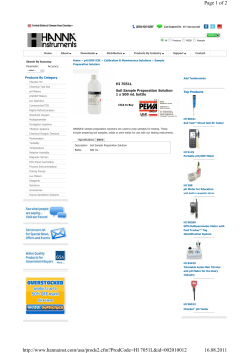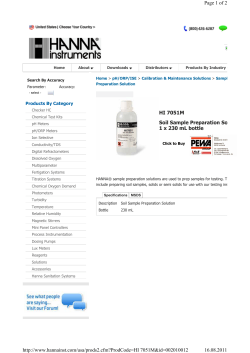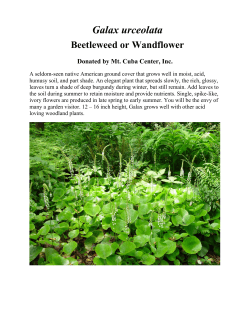
Soil Biology Activities - University of Illinois Extension
SOIL BIOLOGY CLASSR OOM ACTIVITIES For more soil biology information see The Soil Biology Web Page (from the NRCS Soil Quality Institute) at http://www.statlab.iastate.edu/survey/SQI/. Soil Biology Classroom Activity #1 EARTHWORM FARM DESCRIPTION Set up an earthworm farm and watch how earthworms bury surface residue and mix soil. LESSON Earthworms are significant for mixing soil, increasing decomposition of plant material, and improving water infiltration and water holding capacity. BACKGROUND Some earthworms are native to the US, but many species, including Lumbricus terrestris (the night crawler), were introduced from Europe. Most prefer well-aerated, moist soil. Earthworms are uncommon in arid areas, and sandy soil. Ultraviolet light (sunlight) will kill earthworms. Earthworms ingest soil and organic matter, get their nutrition from the microorganisms living in the organic matter, and then egest “casts” – a mixture of soil and organic matter. Where earthworms are common, much of the soil has passed through the guts of an earthworm. The mechanical action of tillage kills some worms, but more importantly, tillage removes the surface residue that earthworms need for food and protection from desiccation and predation. Earthworms especially like fungi, which thrive in minimally-tilled soil. Lumbricus terrestris has many common names including night crawler, dew worm, and angleworm. They are one of several species (called “anecic”) that form deep, relatively permanent burrows. In contrast, “endogeic” species meander around in the upper soil, filling their channels with casts as they go. Both types are important for mixing soil and improving soil structure. Bacteria and fungi decompose organic matter. Worms encourage decomposition by shredding plant residue and mixing it with soil, microbes, and water. Earthworms change the physical structure of the soil in ways that improve the rooting environment for plants and increase the amount of water held by soil. They create burrows that speed the movement of water into and through the soil and provide nutrient-lined channels for root growth. They create casts that become stable soil aggregates. TIME AND MATERIALS • • • • one dozen night crawlers one or two dishpans, or deeper containers. soil to fill the container(s). dry plant material • Allow at least one week for surface residue to disappear and worm casts to appear. Allow several weeks or preferably months to observe soil mixing. PROCEDURE: Earthworms bury plant litter 1) Get a dozen night crawlers. Buy them from a bait shop, or collect them from dark-colored, moist soil. 2) Fill one or two dishpans with soil. Use two pans if you would like to set up an experiment in which one pan has earthworms and the other is a control. However, for demonstration purposes, a single container works fine. Fill the pan(s) with any medium-textured soil. Do not use peat, and do not use soil with much sand— it is abrasive to worms. The soil should be kept moist, but not soggy. Moisten the soil slowly, if needed. You may punch a drain hole in the pan to insure that no water sits at the bottom. 3) Place 6-12 earthworms on the surface of one pan. 4) Sprinkle plant material on the surface. Use dry leaves, grass clippings, or residue from a farm field. Make a single thin layer leaving some soil visible. If you use two pans, be sure both have the same type and amount of material. 5) Make daily observations for at least a week. Look for burrow openings, casts, and the disappearance of plant material. USDA Natural Resources Conservation Service Earthworm farm (cont.) VARIATION: Earthworms mix soil QUESTIONS FOR DISCUSSION 1) Acquire a clear container(s). Build one or two plex iglass containers 2-3 ft. tall, 1-2 ft. wide, and 2-4 inches from front-to-back. (As in the first procedure, the second container is optional, butcan be used as a “control”.) Drill drain holes in the bottom.A fish tank works, but be careful that waterdoes not collect in the bottom,and remember that the amountof soil will be extremely heavy. A two ilter bottle with the top cut off may work, but it may be more difficult to keep the worms alive. 1) Which leaves will decompose faster—t hose buried underground by worms, orthose on the surface? Why? 2) Find soil of two different colors. As mentioned above, avoid sand and peat. Fill the container(s) with 1”-2” layers of alternating soil colors. A sand or clay layer could be added to see how wormsespond r to barriers. Farmers do part of the work of earthworms by tilling residue into the soil. In some deciduous forests with no earthworms, residue piles up. In other places, ants, termites, beetles and other arthropods shred and bury residue. 3) Add earthworms and plant material as in steps 3 and 4 above. Add more plant material as it is consumed. 3) Why is earthwor m activity helpf ul? 4) Observe. If you use two containers, the one without earthworms can be used for comparison as worms change the other. If you use one container , take pictures periodically, or mark the location of the original layers. You can keep the system going, and watch ni creasing amounts ofsoil mixing over months oryears. If the worms die, remove them if possible and add new ones. Buried residue decomposes faster because 1) the worms have shredded it into smaller pieces, so bacteria and fungi have more surface area to work on, and 2) most bacteria need moisture. They cannot live on the dry surface residue. 2) Earthworms do not live everywhere. What happens to surface residue where there are no worms? They encourage decomposition, and therefore, the release of nutrients for use by plants and other soil organisms. They improve the stability, porosity and water holding capacity of soil. They improve water infiltration by forming deep channels and improving soil aggregation. They may improve root growth. 4) When might earthworms be undesirable? In some places earthworms remove surface residue too quickly and leave the surface unprotected from rain and wind. Some forest seeds need a thick layer of plant litter to germinate and begin growing. HINTS Do not overload the system by usingtoo many earthworms, too much surface residue, or too much water. You are not making a compost pile;you are imitatinga farm field or forest floor. EARTHWORM INTERNET RESOURCES Be sure the worms get plenty ofdarkness every day so they can work at the surface. If the container has clear sides, keep it covered most of the time to prevent algae growth. The sides can be uncovered briefly each day,or for a whole day occasionally. Two sites full of earthworm facts: res.agr.ca/lond/pmrc/faq/earthwor.html solum.soils.umn.edu/r esearch/ars/mn_worm.htm A sick worm can infect and kill thewholebatch. Avoid this by removing dead worms quickly (ifpossible), and by starting with healthy worms. They should be plump, quickmoving, and show no physical damag e. A commercially-made worm box: http://www.everything science.net/HS-1236.html Soil Biology Classroom Activities Draft 2/01 A commercial site targeted at K-8 students and teachers: yucky.kids.discovery.com (click on Worm World) A worm farm variation: res2.agr.ca/london/pmrc/faq/worm_farm.html Page 2 of 6 USDA Natural Resources Conservation Service Soil Biology Classroom Activity #2 HOW FAST DOES IT ROT? DESCRIPTION Compare organic matterdecay in different soils. LESSON Decomposition is a biolog ical process performed by living organisms. Soil and climate conditions determine biological activity and,therefore, decomposition rates. BACKGROUND Nutrients are continuously transformed and cycled through the environment.Decomposition by soil organisms is a critical part of these cycles. When plants and animals die, the complex compounds that make up living tissue decompose. Decomposition releases carbon dioxide and nutrients, and makes the nutr ients available again to plants and otherorganisms. covered by plant litter. However, the plant litter on the soil surface will dryout more than if it were buried. Temperature: Bacteria are most active between 70100°F. Dark, baresoil will warm morequickly in spring compared to light-colored soil or soil covered with plant litter. Food: Most microbes need organic matterfor energy and nutrients. Decompositionis faster when the food is high in nitrogen. (Generally, young, green plant residue has more N than brown plant litter .) Harvesting plants and roots from soil means less organic matterleft to feed microbes. pH: A pH of6 to 8 is preferred by most bacteria. Many fungi prefer a lowerpH. Soil can act as either a sink or a source of greenhouse gases. An estimated 30 percent of the carbon dioxide, 70 percent of the methane, and 90 percent of the nitrous oxide released to the atmosphere each year pass through the soil. Soil organisms also decompose would-be pollutants bef ore they reach groundwateror surface water. Decomposition is a stepwise process involving mostsoil organisms. Arthropods and earthworms shred material and mix it with soil. Then a few fungi with a particular enzyme break a specific compound into simpler parts. Then different species of fungi or bacteria can attackthe newly created compounds, and so on. Each or ganism gets energy or nutrients rfom the process. Usually, but not always, compounds become simpler after each step. Some compounds cannot be br oken down any urther. f Theymay combine chemically to become complex, hard-to-degrade organic compounds called humic substances. Humic substances can persist in soil for centuries and are important of r improving the capacity ofsoil to hold nutrients and water. Several factors affect the growth of microorganisms and therefore the rate of decomposition in soil. Oxygen: Most microbes require oxygen (aerobic conditions). A efw are active only in anaer obic conditions. Tillageaerates the soil and temporarilyincreases decomposition rates. Compaction reduces the air in the soil and the space for larger organisms to move around. Water: Soil organisms aregenerallymore active in moist than dry soil. Soil is protected from drying out if it is Soil Biology Classroom Activities Draft 2/01 MATERIALS AND TIME • • • • several types of plant material net bags something to mark the bags’ locations shovel • Allow samples to be buried for up to 2 or 3 weeks. PROCEDURE 1. Collect organic material, such as leaves, grass clippings, residue from a field, or cotton fabric. Avoid kitchen scraps which may attr act animals. 2. Divide the material into two or more identical piles. It is important that each pile have the same kind and size of pieces, because some materials rot faster than others. 3. Pack the residue loosely into net bags. The purpose of the bag is to help you locate the buried residue and carry it back to the classroom. Purchase nettingfrom fabric stores or use bags intended for washingdelicate clothes. Do not use bag s of tightly woven fabric. You want small (1mm) arthropods to get at the residue and help shred it. Page 3 of 6 USDA Natural Resources Conservation Service How fast does it rot? (cont.) 4. Choose places to compare. Identify several soilsthat are managed differently. You might compare: a wooded area away from a path,compacted soil under a path, a farm field, a lawn, a garden, soggy soil, dry soil, dark-colored soil, light-colored soil, a farm field that always has bare soil between the crop plants, and a field that always has plant residue or weeds covering the soil surface. Predict which places have the most biological activity. 5. Bury the bags a few inches down into the soil. Be sure each bag is buried to the same depth.Mark the locations. 6. Examine the results. After two orthree weeks dig up the bags and judge which ones are the most decayed. If there is little difference, you may need to er-bury them for another2 weeks or longer. Alternative procedure MATERIALS • • • 3 X 5 note cards or cotton fabric plastic bags trowel for collecting soil PROCEDURE 1. Collect soil samples. Choose several different soils to compare from the list in #4 above. From each place, use a trowel to scrape away any surface residue and scoop soil into a labeled plastic bag. 2. Add a note card. In each bag of soil, bury an identical piece of note card or cotton fabric. 3. Make your predictions. Which soil do you think will have the most biological activity and will decompose the note card or fabric most quickly? 4. Examine the results. After two orthree weeks look at the note cards or fabric. Which decomposed fastest? HINTS Practice good scientific method and change just one variable at a time. For example, if you want to study the effect of moisture, choose soils that are identical ex cept for the moisture. If you want to study the effect of the kind of material, be sure to burysamples in identical soils that have similar moisture contents. The optimal length of time for leaving samples in the soil varies from place to place. The first time you do this activity, allowtime to learn what is best in your situation. QUESTIONS FOR DISCUSSION 1) Where does decomposition ofplant residue ift in a diagram of the food web/chain? Only a fraction of plant matter is eaten by above-ground herbivores. Most is consumed by the decomposers underground and enters the complex network of organisms called the soil food web. Energy and nutrients return to the above-ground food web when plants grow and animals eat plants and soil organisms. 2) What characteristics of the soil will increase biological activity and therefore decomposition rates? How do we affect those characteristics in the soil? (See Background.) 3) What characteristics oforganic matterdetermine how fast it decays? Compared to large pieces, small pieces have more surface area for the bacteria and fungi to attack. Low nitrogen content relative to carbon (high C:N ratio) will limit the activity of microbes. Woody materials contain lignin and other compounds that are difficult to break down. INTERNET RESOURCES Carbon cycle: http://library.thinkquest.org/11226/ Nitrogen cycle: http://clab.cecil.cc.md.us/f aculty/biology/jason/nitrc.htm http://www.bae.ncsu.edu/courses/bae578/nitrog en.html Organic matterand decomposition: http://www.montana.edu/wwwpb/ag /baudr150.html http://www.agric.gov.ab.ca/agdex/500/536-1.html Soil Biology Classroom Activities Draft 2/01 Page 4 of 6 USDA Natural Resources Conservation Service Soil Biology Classroom Activity #3 WHAT LIVES IN YOUR SOIL? DESCRIPTION OF ACTIVITY Berlese Funnel Use two techniques to ex tract large and small arthropods from soil. Students may identify the organisms, estimate numbers, or compare populations in dif ferent places. MATERIALS AND TIME REQUIRED LESSON A wide variety of organisms live under our feet and perform important roles in the envir onment. BACKGROUND “Arthropods” is the name for a large group of invertebrates with jointed (arthros) legs (podos). In the soil, they may be mi croscopic or several inches long. They include insects (springtails, beetles, and ants); crustaceans, (sowbugs); arachnids (spiders and mites); myr iapods (centipedes and millipedes); and scorpions. • • • • • • • Trowel and plastic bags for gathering soil. Large funnel (2-literbottle, or plastic milk jug ) 2 mm mesh screening Jar or cup Preservative (ethanol or 50:50 ethanol/water mix) Incandescent, 60W light bulb and ifxture Dissecting microscope • Allow one weekafter set up to collect samples. PROCEDURE 1. Gather soil samples Arthropods are easiest to ifnd in soil that is rarely disturbed by tillage, not compacted by traffic, not treated with pesticides, not per iodically flooded or dried out, and that has several different kinds of plants growing. Push away the sur face litter Arthropods are important because they stimulate microbial and dig up about 1 liter of soil from the top few activity and enhance decomposition; they help contr ol pest centimeters of the soil. (In anotherexperiment, plant populations; and they improve soil ucture str as they litter can be used in place of soil in a Berlese funnel.) burrow through the soil or excrete fecal pellets made of Refrigerate sample if you will notuse it right away. soil and organic matter. Good structure is important for improving water intake, drainage, and aeration, thus 2. Set up the Berlese funnel. Cut off the bottom of protecting soil from erosion, and creating a good the bottle ormilk jugto make a funnel. Cut and place environment for roots. the screen in the bottom ofthe funnel to hold the soil. It may help to tape the edges of the screen to the A single square yard of soil maycontain 500 to 200,000 funnel. Half fill ht e funnel with soil. Set the funnel individual arthropods and tens orhundreds of different above a jar or cup with a bit of ethyl alcohol in the species. Most live in the top few centimeters of soil. A bottom. (Glycer ol can be added to reduce evaporation.) Berlese (pronounced “bur LAY zee”) funnel can be used Set up a desk lamp orhang a light bulb so the bare 60W to collect microscopic arthropods from soil.A pitfall trap bulb is about 4 inches over the soil. can be used to gather larger arthropods. 3. Collect the organisms. Leave the light bulb on for 3-7 days to dry out the soil. As the soil dries, organisms will movedeeper into the soil and eventually fall into the alcohol. Avoid distur bing the setup and knocking soil into the alcohol. 4. Examine the sample. Pour the alcohol solution into a petri dish and examine undera microscope. Put black paper and white paperbehind the sample to hig hlight different organisms. Identify the main groups of arthropods. An identif ication key is at www.cals.ncsu.edu/course/ent591k/ident.html Soil Biology Classroom Activities Draft 2/01 Page 5 of 6
© Copyright 2025









